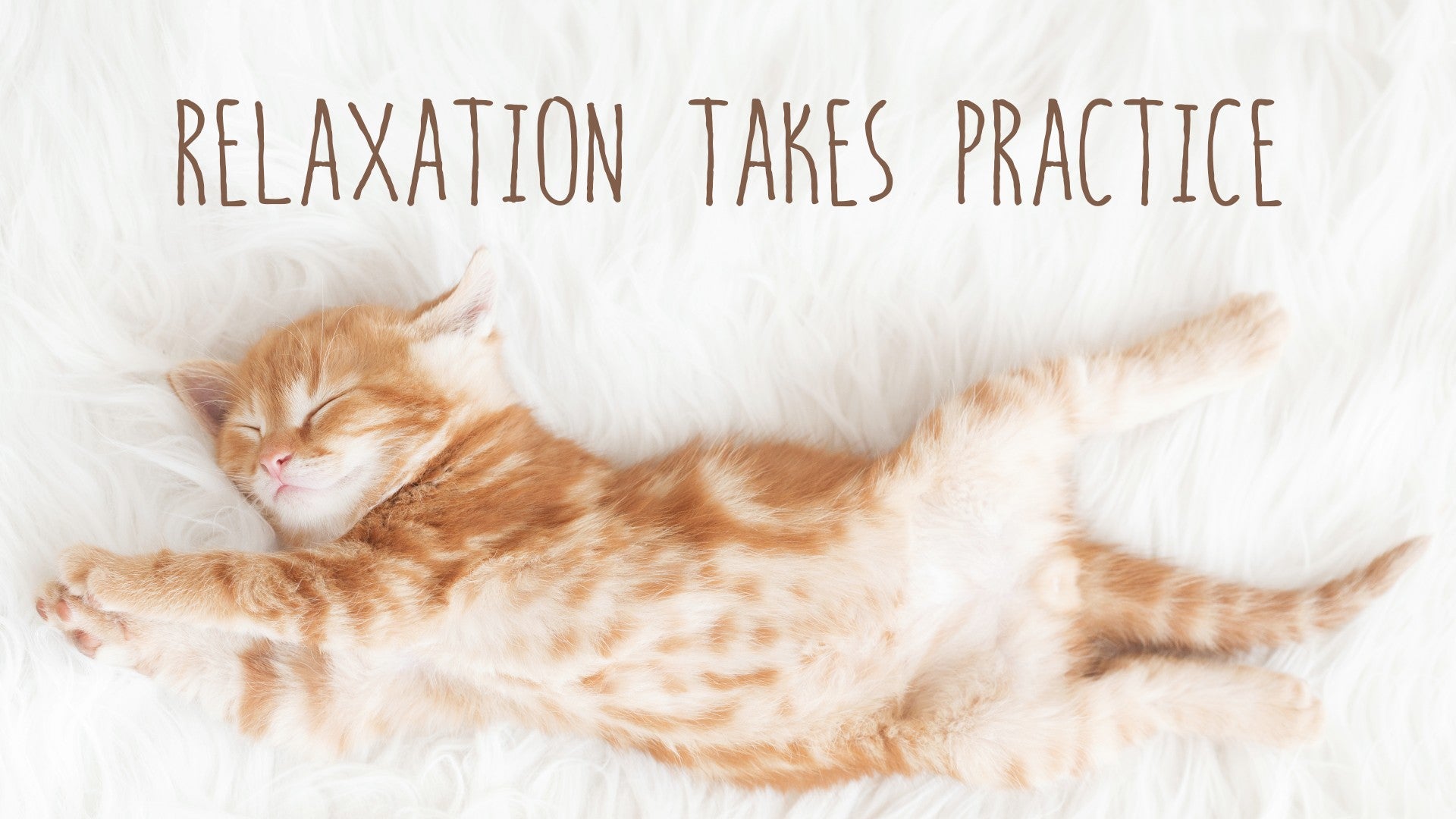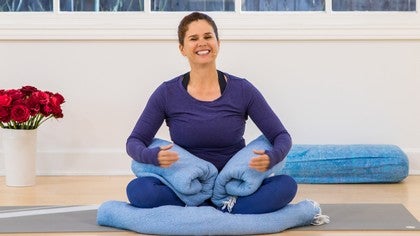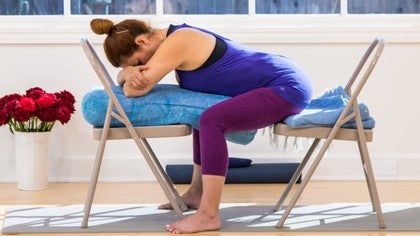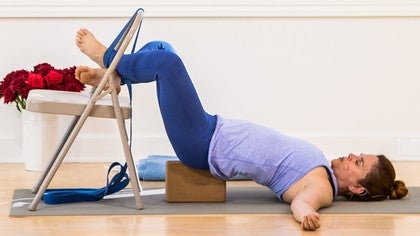Description
About This Video
Transcript
Read Full Transcript
(waves crashing) Hi everyone, welcome to Yoga Anytime. This is the third and final practice of the Breathing and Feeling series. It is a restorative practice that also includes a breathing practice, which you'll be doing at the very end. We're pretty much focusing on getting this whole area around here to stay really open so that the sitting is very comfortable. But don't worry, we'll be propped up enough so that you should be pretty comfortable.
Here are the props that you need. You need three blankets, one bolster, one chair, one sandbag, and one block. The first pose that we're starting with is parivrtta janu sirsasana. So I have a chair that's facing the side of my body. I have a blanket folded on top and then one in the sandbag.
So we're gonna take the sandbag, we're gonna bring it out to the side. Sit down and stretch the left leg all the way through the chair. You can pull the chair in closer to you if you like. And that left leg can come as far through the chair as you want, you just need to be close enough so that when you go into the side bend, you're not trying to get to the chair. We're gonna take this sandbag and you have two options.
The first option is to have your leg like this in a baddha konasana. In that case, you would place the sandbag right here on the very top of the thigh. Or you can bring that leg in virasana, hero's pose, which be to fold it back behind you. So depending on what your needs are. I'm actually going to practice it like this because we're going into a camel pose later on where this stretch will be helpful.
So the same thing, I'm gonna place that sandbag at the very top of my right thigh. Get nice and long as you inhale. Firm this straight leg a little bit. Slowly begin to bend at that left waist and let your head just reach right on top of that support. You can hold on to the backrest of the chair if you want with your hand or you can just rest it on the floor, it doesn't matter.
Then on an inhalation, sweep your right arm all the way up, grab hold of the backrest of the chair. If you want a little less sensation, just drop that arm all the way on the seat of the chair. If you want a little bit more, you can walk to the center. You can walk all the way across to the left. Or you can go somewhere in between where you're maybe to the right corner, so you just decide where you want it.
Let the weight of that head continue to release. And now that you've got that bag on that thigh, you should start to feel that long sensation that beings to develop around the side waist. We're gonna be here one full minute starting now. And notice any sensation you have developing in the neck. You can kind of move your head forward or to the back a little bit, just kinda trying to figure out the best place for that head to rest and be fully supported.
And you can also go back from holding onto the chair to letting the arm rest on the chair. It doesn't matter, just keep moving with the tide of the feelings as they surface. Go ahead and take one more inhale and exhale. If your arm is holding on to the back of the chair, go ahead and rest it now on the seat of the chair. And then use an inhalation to come all the way up to the center.
And exhale, just pause, relax. So let's go to the other side. And remove the bag. Come out of my leg position and then just pick up the chair, bring it all the way over to the opposite end of the mat. And then scootch the right leg all the way underneath.
Decide how you wanted that leg. And it's okay to do the leg different than you did the first one. Maybe you're nursing a little bit of an injury or something and that's okay to do. So we'll take the bag, whichever position that leg is in, put it on the top thigh. Just gonna make sure I'm kind of close to the chair, close enough.
So an easy inhale that lengthens your spine a little bit and then as you exhale, go ahead and bend at that right waist and take your head gently down to the support. You can either hold on to that back bar if you want or just let that arm go. And then on an inhale, sweep the left arm all the way up just like you did before. And maybe this time you hold on to the back of the chair, or maybe this time, the arm comes down. You decide where you want it.
But there's no pulling with that top arm if you're holding on to that chair. It's just a softening that you're letting go. Just a release. Once you've got yourself settled and your head feels like it's supported, then we'll start that full minute right now. Some smooth breaths.
Notice that sensation that may be beginning to percolate at the left waist. And see if it's possible for you to just let it come in easy and let it go out easy also. Right, so you welcome it in. And you let it just pass through. And go ahead and take one more inhale and exhale here.
And if that top arm is holding on to the back of the chair, go ahead and release it and just let it rest on the seat of the chair. And then you'll use an inhale to lift all the way up to the center. And exhale, pause. Close your eyes. Feel the effects of what you just did.
Okay. So opening the side waist like that is really helpful for the next pose that we're going into which is a variation of ustrasana, camel pose. But we're also gonna be doing baddha konasana, bound angle in it as well. We no longer need the sandbag so we can move that out of the way. Let's take it off the leg and come out from that bend.
And then just slide this out of the way. And now it's time to grab your block because you're gonna use that for head support. So you can keep this blanket on top of the chair if you want as a little bit of cushion. You could flip it this way so that it just hangs over the front lip. Or you could get rid of the blanket altogether and maybe you want to sit on it, it doesn't really matter.
I'm gonna keep it here because I like that little cushion up against my back. I'm gonna take the block and put it on its long, thin side but again, depending on what your needs are, you may need to go lower or you may need to go a little higher. So I'm gonna put it right here on the long, thin side. I'm gonna now take the back side of my body up against the chair. And I'm just grabbing onto the front legs of the chair and kind of scootching my body back until I feel that it's met the chair.
And it should come right at the base of the shoulder blades. Then I'm gonna take the soles of the feet and bring them together in the baddha konasana and I was just thinking, you know, you could put a sandbag actually on the feet too, that might feel kinda nice. And I'm gonna, since it's nearby, I'm gonna grab it. And just put it, oh yeah, that's good. (laughing) Just put it right on the feet. Let's move it this way.
Okay, so then, I hold on to the front legs of the chair, broaden through the inner thighs a little bit, lift my chest a smidge, and then exhale, begin to lower and I can just reach back and grab that block so that it fits right underneath my skull and then hold on to the back of the chair with my hands. The higher I go, little less sensation will develop. The lower I go, more will develop, so go to a place where you can be with the sensation. We're gonna be here a minute and a half. So release the weight of the skull.
Let's the shoulders totally relax. Feel free to move your hands down to your legs rather than going for the stretch of the shoulders. And now that side waist is really helped to open the front waist and the back waist in this pose. Just breathe. And the more this pose comes to you, the more you can really sink into it so make sure you've got the right support at your head.
We're gonna stay just a little bit longer. Listen to the breath that you're taking right now and then follow it with five more slow inhales and exhales. Just as you feel those sensations beginning to rise know that they can also fall as well, just like the breath. So you don't have to necessarily hold on to the sensation, you can use the exhalation as a way to invite the sensation to pass by. Alright, so there's no gripping in the head that needs to take place.
When you finish that fifth one, if your hands are holding on to the chair, go ahead and release them and just let them rest down to your legs. And then you're gonna push your hands right up against the floor, straighten through your arms, tuck your chin to lift your head and then push away from the chair so you're in the upright position. You can remove the bag. Bring the hands to the outer knees and join your knees and stretch your legs straight out in front of you. Then just pause.
Just close the eyes, pause. Feel the effects of that back bend and the hips at the same time. These poses, they look so unassuming right, and then you get in them and then you feel the effects of the opening afterward. I think it's pretty great. Okay so we're headed to the next pose which is sort of what I call a simple pigeon pose.
I'm gonna move the bag out of the way because we don't really it and I'm gonna turn my body around. And we're not gonna be needing the block so I'm gonna push that out of the way as well. The blanket can stay on the seat of the chair or if you were sitting on it, you can stay sitting on it as well. The pigeon, the easier simply pigeon pose, goes like this. We're gonna straighten our legs out and just let them come right underneath the chair.
I'm gonna hold on to the inside of my left knee and draw that leg all the way in. And then I'm gonna let the leg go out to the side. That's kind of an important piece. And the reason why it's important is because, instead of just bending at the knee, what I want is I want the soft tissue to help guide me in the rotation so I'm grabbing hold of that leg and just letting it roll out to the side. Grabbing ahold of the other knee, picking it up, letting it roll out to the side.
Then from there, bring my hands alongside the hips. Lift the hips up off the floor and start walking my feet in opposite directions of one another until I see that I've made pretty much a box and then drop the hips down to the floor. So sukasana is a little different, right, it's more of the cross legged or out here. More of a pyramid shape. This one is really more of a box shape so do the best you can.
And this chair, this chair leg, I push my foot up right against it so it gives me a little bit of feedback as well. Take an inhale, lift the spine, and as you exhale, start to come forward. Bring those elbows on the seat of the chair and let the head go. Relax the shoulders. Most likely you'll feel more stretch in the front leg which is the right leg, and it's one full minute here.
And anytime you need to, you can move away from the chair a little more or you can push the chair forward a little bit more. You can also stack your fists if you need a little bit more height. You can hold on to your head up here, not that you're worrying (laughing) but you can get a little bit more height that way. So you can decide the right place for you to be. Again, the closer the chair comes to you, the more comfortable you'll probably be.
Or the more the pose comes to you. Listen to the breath you're taking and take one more. And then just lift your head, press your palms into the seat of the chair, push away from the seat of the chair until you're upright. And we're gonna bring the legs out in front of us again so I just grab ahold of the outer legs, draw them in toward one another and stretch the legs straight out. And just pause for a moment, maybe firm your legs a little bit.
This important piece of the restorative yoga is that you're not going for the greatest depth of sensation, you're just going for the tiniest bit of sensation and that way we can stay a little bit longer and we can actually get the nervous system to calm down a little bit. So although it may seem like, oh gee, I want more, in this case, really that's not what we want. What we want is just enough so that we can manage a smooth and steady breath and feel as though we're beginning to build a relationship with the quietness of the pose, with the softness and the silence of the pose. Okay, so let's go into the other side. So I'm gonna bend the right leg first.
Hold on to the inside of that knee. Just bring that leg out, do the same thing. Now I'm gonna bring my hands alongside the hips, straighten the arms to lift the chest, lift the pelvis off the floor, and start walking my feet in opposite directions. And again, I like to use that leg of the chair, just as a little feedback for that front foot but you don't have to. Set the hips back down to the ground.
Get into the best box that I can. Then press the hands on the seat of the chair. We take the inhale, just get a little bit of length. And exhale, hinging, coming forward. Decide how you want to position your arms and then take your head down.
The head has to rest on something, right? This is a way to calm the nervous system down so there's no reaching through the eyes at all. This is important for the head to be down so even if you find yourself it's better to be up here. Alright, have your head on something so that you can get that information, the brain can get the information. Relax the shoulders.
Relax the weight of the head and let's take that full minute now. Feel free to adjust the last little bit, either your arms or your legs. And go ahead and take one more inhale and exhale here. And then on the inhale, lift the head and the chest. Press your palms flat to the seat of the chair.
And come all the way up. Just pause for a moment. We're gonna bring the hands to the outer legs and you can lean back a little bit, stretch those legs out in front of you and then firm the legs a little bit as well. And just pause. So for the next pose, we're doing upavistha konasana and we actually don't need the chair and we don't need the blanket unless it's something that you think that you need to sit on.
If you were sitting on it in the last two poses, you'll probably wanna sit on it in the next one. So we're gonna get what we need which is really just a bolster. So I'm gonna push everything out to the side and get the bolster. Okay, so we've got the bolster and I've placed it so that it's parallel to the mat and here we go into upavistha konasana. Go ahead and sit down.
Bring the legs anywhere from a 90 to 120 degree position and slide that short edge of the bolster right up against your pelvis, you wanna feel your belly hit it. Then firm the legs a little bit, take an inhale, get a little bit of length, and then once again, don't go for your biggest reach, right, let's just go for a little. Like it's okay to be silver or bronze. So here we go taking an inhale and exhale, lowering. And turn our head to the left.
Elbows and forearms to the floor. And it's one full minute on both sides of the face. Head is heavy. Legs are still firm. If you found that this was a little too much sensation for you you can also grab another blanket and put it on top of the bolster so that the bolster comes a little closer to you.
Once again, that's bringing that pose a little closer to you. Go ahead and take a slow inhale and exhale. Tuck your chin, turn your head to the opposite direction. And then we'll be here for one more minute. If at any time you need to come out of the pose before you hear the instruction, feel free to do that.
You can just pause in an upright position. You may feel the feelings of the legs really stretching, the sensations beginning to develop. The question, the inquiry is can I be here for the full minute and if I can't, how would I like to be? In restorative yoga, the idea is to be comfortable. To feel as though you don't really wanna come out.
So make sure that you have enough support so that's the kind of answer that you have to that inquiry. And take another easy inhale and let that exhale just wash through you and then tuck the chin and turn your head to the center so your forehead comes down to the bolster. You can just walk your hands right underneath your shoulders and inhale, push through the arms so that the arms are now straight and you come all the way up. Just pause a moment. Those forward bends do it every time, they just, they take you down, they take you in.
So those are good poses to do before seated pranayama or seated breathing. And we don't need the bolster anymore so we're gonna actually move it out of the way. I'm gonna hold on to the insides of my legs and bring them in a little closer. And then remove the bolster and bring it to the side. And we're gonna fold these blankets a little bit, or actually roll them.
So two of them are gonna get rolled the exact same way. So they're right now folded in the long fold, long double fold, so I'm gonna unfold that and instead, I'm gonna fold it so that it's in half and I call that a meditation pad. And I'm gonna take the short end of it, the short folded clean side, and I'm gonna roll it so it makes this little short burrito. And then the same thing with this one. Now, you can roll them in different configurations, right.
I'm kind of little (laughing) so this works for me but it's certainly okay to also roll them from here, right, so you can decide what it is that you really want. You could also roll it from here without folding it a second time. So you decide what makes good for your body. Now that I have those two, I'm gonna grab this other one and you may or may not wanna use it. And I'm going to unfold it so that it's this long, right.
So now it's just folded in half and folded in half again. And then from there, I'm gonna roll it again from that long clean, and it's important to try to keep your props, you know, as tidy as possible so that the rolls aren't sloppy because they're supporting your body. And we care about that. So you can sit in any seated position that is like a sukasana or you can even come a little further out with your legs. This is the position I like to sit in.
It's really just a sukasana. I'm grabbing that long roll and just placing it right underneath my shins and knees so that my knees get some feedback. Again the brain goes, okay I can tell the nervous system to mellow out a little bit. It doesn't have to fight, right, it can just really relax. Here's the goodness of this.
I sink that right into my leg and my torso. And it's important to actually point the blanket down, and here's why. We want the arm to really release down so that the hand comes lower than the elbow so you're not up like this, right? You're not upright. It's all about you going down and in.
So I'm grabbing the other one. I point them down. Ah, it's so good. It's so good. I hope it's good for you as well. (laughing) So you can mess with these, right, a little bit to get it just right but it should come like right in where you're just all like nestled in.
Okay, so you can hold your hands however you prefer. We're gonna close the eyes and I'm gonna guide you through this particular breath. The breath is to start taking in maybe two or three inhales and count them quietly to yourself. When you figure out what the count is, after the third breath, like you go okay, that's the longest breath that I can take in that's not like, feels like I'm taking in too much breath, then you're gonna drop off two counts. For instance, if you were to count your breath and you figured out, okay, 10 is the most amount of breath that I can bring in, then I want you to drop it off to eight and that's what is gonna be your count for your inhale and your exhale.
So here we go, close your eyes. Take the front of your throat slightly toward the back of your neck. Let your chin just descend a little bit. You don't have to bend at your neck, just let it drop back a little bit. So you feel that soft front of the throat, relax toward the back of the neck.
Now start to take a long inhale. Count it in your mind and then just let the exhale go. And do that two more times. Get really clear about what you think that count is. When you've figured out what the count is, I'd like you to drop off two counts.
And then that's gonna be the count of your exhale as well. Once you've handled it, start. We'll go for a minute and a half. In your mind, count your inhale and count your exhale. And allow as many natural paced breaths to occur after that.
Then, invite the count in again. And see if you can let the natural breath time not be any specific time. Almost like it's just this natural invitation, you go oh I feel now ready to take the big breath in, right, there's no logic to it. It's just a feeling that you're following. Keep going.
If you get distracted, just follow your distraction back to another set of breath. Complete the set that you're on and follow with two more. When you finish the second one, let your breath just drop out into normal paced breaths. Be still. In just a little bit, I'm gonna invite you to open the eyes.
But when you do, see if you can let the very outer edges of the eyes sort of broaden or widen as if the eyes were lengthening out to the sides and you were taking in the landscape rather than reaching for it with your gaze. Go ahead and gently open the eyes. Okay. So we're ready for shavasana now. We'll be in it for five minutes and you can use whatever you want for support or without support.
What I typically like is just one blanket for my head and one right across my belly. So I'm just gonna use the two. Neatly fold the other one that I'm not using, push it to the side. Once you get yourself set, your legs position in anything, in any position that feels good. Just make sure that the shoulders are broad and release to the floor.
Let your arms fall out with the palms turned up. And this is a completely silent shavasana for five minutes beginning now. Start to become aware of the space around you and the solid ground beneath you. And take some longer inhales and some deeper exhales. If you have a blanket on top of you that needs to be removed, you can do that but first just move around through your fingers and toes and your wrists and your ankles a little.
You can bend your elbows and let your hands just rest gently against your body, your belly or your chest. And if the blanket is on top of you, go ahead and remove it. Just push it to the side. Bring your right arm out to the side. Bend your left knee so your left foot is flat.
Push off the left foot, roll yourself over to the right. When you get there, just pause. And lean your chest toward the floor. Push through your palm to come up. Come into any comfortable seated position you prefer.
Bring your hands down to your legs. Close your eyes for just a moment. Notice a difference, right, when you come out of shavasana but particularly when you've first done this kind of breathing. It really, really sets you up for a good shavasana and perhaps you feel like you're in the world now but you're not, you're of the world but not necessarily in it. This steadiness that you feel, the seeds that you're planting for steadiness throughout the rest of the day.
Gently open your eyes and join your palms to your chest. Thank you for joining me today. Namaste.
Relaxation Takes Practice
Comments
You need to be a subscriber to post a comment.
Please Log In or Create an Account to start your free trial.









